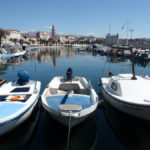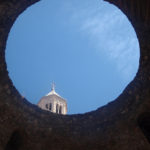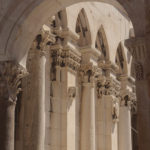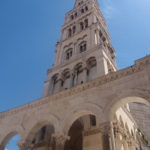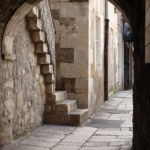Gallery
Split (pronounced [splît]) is the largest Dalmatian city, the second-largest urban centre in Croatia. The city is located on the shores of the Mediterranean, more specifically on the eastern shore of the Adriatic Sea, spreading over a central peninsula and its surroundings, with its metropolitan area including the many surrounding seaside towns as well. An intraregional transport hub, the city is a link to the numerous surrounding Adriatic islands and the Apennine peninsula, as well as a popular tourist destination.
Split is also one of the oldest cities in the area, and is traditionally considered just over 1,700 years old, while archaeological research relating to the ancient Greek colony of Aspálathos (6th century BC) establishes the city as being several hundred years older.
Split has a Mediterranean climate; hot, relatively dry summers and mild, wet winters. Average annual rainfall is in excess of 820 mm (32.28 in). July is the hottest month, with an average high temperature around 30 °C (86 °F). January is the coldest month, with an average low temperature around 10 °C (50 °F). November is the wettest month, with a precipitation total of nearly 113 mm (4.45 in) and 12 rainy days. August is the driest month, with a precipitation total of around 43 mm (1.69 in) and 5 rainy days. Winter is the wettest season, however it can rain in Split at any time of the year. Snow is usually exceedingly rare, but the months of December, January and February have each accrued an average of 1 snowy day since record-keeping began. Split receives in excess of 2,600 sunshine hours annually.
In 1979, the historic center of Split was included into the UNESCO list of World Heritage Sites. Split is said to be one of the centres of Croatian culture. Its literary tradition can be traced to medieval times, and includes names like Marko Marulić, while in more modern times Split excelled by authors famous for their sense of humor. Among them the most notable is Miljenko Smoje, famous for his TV series Malo misto and Velo misto, with the latter dealing with the development of Split into a modern city.
Despite colorful settings and characters, as well as a cinema tradition that could be traced to early 20th century works of Josip Karaman, there were relatively few films shot in or around Split. However, the city did produce several famous actors, most notably Boris Dvornik.
Also well known is Ivo Tijardović, and his famous operetta “Little Floramye” (Mala Floramye). Both Smoje and Tijardović are famous artists thought to represent the old Split traditions that are slowly dying out due to the city being overwhelmed by large numbers of rural migrants from the undeveloped hinterland. The old Split families still cling to the littoral Dalmatian way of life and values, often publicly stating their disgust at the ruralization of the ancient city.
Sportsmen are traditionally held in high regard in Split, and the city is famous for producing many champions. The most popular sports in Split are football (soccer), tennis, basketball, swimming, rowing, sailing, waterpolo, athletics, and handball.
The main football (soccer) club is HNK Hajduk, the most popular club in Croatia supported by a firm known as Torcida Split, while RNK Split is the city’s second club. The largest football stadium is the Poljud Stadium (HNK Hajduk’s ground), with 35,000 capacity (55,000 prior to the renovation to an all-seater). Basketball is also popular, and the city basketball club, KK Split (Jugoplastika Split), holds the record of winning the Euroleague three consecutive times (1989–1991), with notable players like Toni Kukoč and Dino Rađa both of whom are Split natives.
Split’s most famous tennis stars are the retired Wimbledon champion Goran Ivanišević, and Mario Ančić (“Super Mario”). Members of the local rowing club HVK Gusar won numerous Olympic and World Championship medals.
Swimming also has a long tradition in Split, with Äurđica Bjedov (1968 Olympic Gold Medal and Olympic record in the 100 m breaststroke), Duje Draganja and Vanja Rogulj as the most famous swimmers from the city. As a member of the ASK Split athletics club, the champion Blanka Vlašić also originates from the city. The biggest sports events to be held in Split were the 1979 Mediterranean Games, and the 1990 European Athletics Championships.
Split is one of the host cities of the 2009 World Men’s Handball Championship. The city constructed a new sporting arena for the event, the Spaladium Arena. Its capacity is 12,000 spectators (in basketball events). The cost of the arena was evenly divided between the city and the government.[29]
Picigin is a traditional local sport (originating in 1908), played on the famous sandy beach Bačvice. It is played in very shallow water (just ankle deep) with a small ball. Picigin is played by five players. The ball is the peeled tennis ball. There is a tradition of playing picigin in Split on New Year’s Day, regardless of the weather conditions, in spite of the sea temperature rarely exceeding 10 °C.
RK Nada are the most successful rugby union club in the Balkan region, with 11 titles in the Yugoslav championship and 14 in Croatia since independence.




